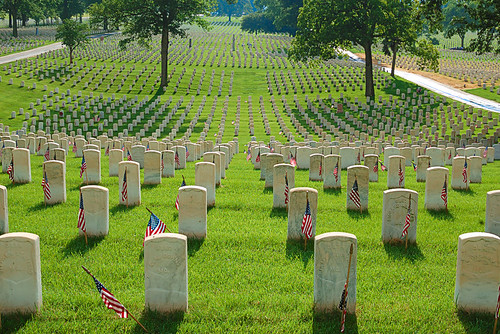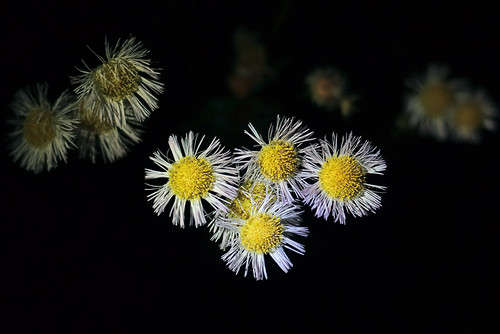
Pages
▼
Monday, May 31, 2010
On Patriotism
MEMORIAL DAY is a federal holiday in the United States, which observes the memory of those who fell while in military service to the country. Memorial Day is observed on the last Monday in May. November 11th, observed as Remembrance Day in much of the English-speaking world in memory of the fallen, is called Veterans Day in the U.S. in honor of all those who have served in the armed forces.
Patriotism is a virtue, and like any virtue, can be contrasted with vices of excess and of deficiency. In excess, in consistently supporting the leadership even in wrongdoing, or in idolizing the state above God; in deficiency in resisting the due honor and obedience deserved by the country's rulers.
Love of country is a good thing. But what kind of love? Agape love is the selfless giving of oneself for another; while this is admirable when directed towards one's family, friends, or neighbor, this may approach idolatry when applied too strongly to the State itself. Eros love, or the love of desire, is perhaps an inappropriate love of country, if that is the sole love you have for it: “I love my country only when it gives me something” is at best childish. Rather we should look to the love of friendship — “we are all in this together and we have a common goal”; and also perhaps the love of affection — “I love my country because it is mine, not only because its goodness, and despite its flaws.”
Our duties to our country are largely based on the principle of justice, and closely related is the principle of piety, which extends beyond just worship due to God, but also our relationships with our family and the state.
According to the Catholic Encyclopedia entry on Civil Allegiance:
War is a terrible thing, and besides just remembering or memorializing those fallen in service, perhaps we can offer up a prayer for their repose.
Patriotism is a virtue, and like any virtue, can be contrasted with vices of excess and of deficiency. In excess, in consistently supporting the leadership even in wrongdoing, or in idolizing the state above God; in deficiency in resisting the due honor and obedience deserved by the country's rulers.
Love of country is a good thing. But what kind of love? Agape love is the selfless giving of oneself for another; while this is admirable when directed towards one's family, friends, or neighbor, this may approach idolatry when applied too strongly to the State itself. Eros love, or the love of desire, is perhaps an inappropriate love of country, if that is the sole love you have for it: “I love my country only when it gives me something” is at best childish. Rather we should look to the love of friendship — “we are all in this together and we have a common goal”; and also perhaps the love of affection — “I love my country because it is mine, not only because its goodness, and despite its flaws.”
Our duties to our country are largely based on the principle of justice, and closely related is the principle of piety, which extends beyond just worship due to God, but also our relationships with our family and the state.
According to the Catholic Encyclopedia entry on Civil Allegiance:
By civil allegiance is meant the duty of loyalty and obedience which a person owes to the State of which he is a citizen. The word allegiance is a derivative of liege, free, and historically it signifies the service which a free man owed to his liege lord. In the matter in hand its meaning is wider, it is used to signify the duty which a citizen owes to the state of which he is a subject.From the Catechism of the Catholic Church, section on the duties of citizens:
That duty, according to the teaching of the Catholic Church, rests on nature itself and the sanctions of religion. As nature and religion prescribe to children dutiful conduct towards the parents who brought them into the world, so nature and religion impose on citizens certain obligations towards their country and its rulers. These obligations may be reduced to those of patriotism and obedience. Patriotism requires that the citizen should have a reasonable esteem and love for his country. He should take an interest in his country's history, he should know how to value her institutions, and he should be prepared to sacrifice himself for her welfare. In his country's need it is not only a noble thing, but it is a sacred duty to lay down one's life for the safety of the commonwealth. Love for his country will lead the citizen to show honour and respect to its rulers. They represent the State, and are entrusted by God with power to rule it for the common good. The citizen's chief duty is to obey the just laws of his country.
2238 Those subject to authority should regard those in authority as representatives of God, who has made them stewards of his gifts: “Be subject for the Lord's sake to every human institution. . . . Live as free men, yet without using your freedom as a pretext for evil; but live as servants of God.” (1 Peter 2:13,16) Their loyal collaboration includes the right, and at times the duty, to voice their just criticisms of that which seems harmful to the dignity of persons and to the good of the community.See also the section on SAFEGUARDING PEACE, which discusses the legitimate use of the military to safeguard peace, and also the obligation to avoid war.
2239 It is the duty of citizens to contribute along with the civil authorities to the good of society in a spirit of truth, justice, solidarity, and freedom. The love and service of one's country follow from the duty of gratitude and belong to the order of charity. Submission to legitimate authorities and service of the common good require citizens to fulfill their roles in the life of the political community.
2240 Submission to authority and co-responsibility for the common good make it morally obligatory to pay taxes, to exercise the right to vote, and to defend one's country:
Pay to all of them their dues, taxes to whom taxes are due, revenue to whom revenue is due, respect to whom respect is due, honor to whom honor is due. (Romans 13:7)The Apostle exhorts us to offer prayers and thanksgiving for kings and all who exercise authority, “that we may lead a quiet and peaceable life, godly and respectful in every way.” (1 Timothy 2:2)
[Christians] reside in their own nations, but as resident aliens. They participate in all things as citizens and endure all things as foreigners. . . . They obey the established laws and their way of life surpasses the laws. . . . So noble is the position to which God has assigned them that they are not allowed to desert it. (Epistola Ad Diognetum 5:5)
War is a terrible thing, and besides just remembering or memorializing those fallen in service, perhaps we can offer up a prayer for their repose.
Feast of the Visitation - Feast of the Queenship of Mary
MAY 31st in the traditional calendar is the Feast of the Queenship of the Blessed Virgin Mary, and in the new is the Feast of the Visitation.
Immediately after the Annunciation, Mary travels to the hill country, to visit her kinswoman Elizabeth, who despite being thought barren, was pregnant with John the Baptist. The passage of the Visitation in Luke 1 strongly parallels 2 Samuel 6, where King David brings the Ark of the Covenant to his city, where John in the womb leaps for joy at at the coming of Mary, as David leapt for joy as the Ark drew near.
The old Ark of the Covenant, according to tradition, contained the Word of God on the tablets of the Commandments, some of the manna from heaven which fed the Israelites in the desert, and the wooden staff of the High Priest Aaron, which blossomed; and upon the Ark God's spirit settled. All of these things figure greatly in ancient messianic prophesy, and so the Old Testament type of the Ark of the Covenant, we ought to expect, will be fulfilled in the New Testament in a greater and more wonderful way. And so, Jesus Christ is the Logos or Word of God, he is the new Manna from Heaven in the Eucharist, and as being a ‘sprout from the root of Aaron’ or descendant, is the new High Priest.
Recall that New Testament fulfillments are greater than Old Testament types. As the design of the old Ark of the Covenant was given directly by God, according to Exodus, we ought to expect that the design of the Ark of the New Covenant to be pleasing to God in a more wonderful way. Mary is the new Ark, and all those things which were written of the old Ark ought to be fulfilled in a more marvelous way. Instead of being a box of wood, the new Ark is living flesh, instead of containing symbols of God's majesty, God Himself is contained. And both Arks were sacred and untouchable.
All too often Protestantism is defined as being not Catholic which is a shame. But let us consider this passage from the Visitation, found in Luke, and spoken by Mary:
In Evangelical Christianity, the only important relationship is between the individual believer and Jesus; in Liberal Christianity, the only important relationship is between the individual and the spirit, although it is unclear if this is the Holy Spirit or the spirit of the age. All other relationships are left to the opinion of the individual, and are typically based on custom, personal preference, force of law, or worldly philosophy and not religion.
But in Catholic and Orthodox Christianity, there are very many relationships; between us and Jesus, us and the Holy Spirit, us and God the Father, us and the Blessed Trinity one God, us and the Angels and Saints in Heaven, between the Saints themselves and with God, between the Divine Persons of the Blessed Trinity itself, between us and our peers, us and our leaders, us and our dependents, us and animals, us and the inanimate created world, and between God and the created world. These relationships have a theological and moral dimension and are guided by the principle of right relationships, a hierarchy of greater and lesser honor, dignity, duty, and responsibility. Denying these right relationships leads to egotism at best, and at worst, Satan's unwillingness to serve.
Our word ‘religion’ comes from the Latin religio, meaning bond, obligation, reverence — right relationships, and the word ‘piety’ has a much larger meaning encompassing even worldly relationships such as the family and the state.
In this system, the relationship between spouses has a greater dignity and honor than a parent in relationship to a child; the relationship of a sibling to his parents is greater than that with his other siblings; a citizen owes more to his ruler than to his peers; a ruler has more responsibility over his subjects than to his peers. We give more dignity to a human than to an animal, and more to an animal than a plant, and more to even a plant than the due consideration given to inanimate objects. Likewise, we give greater honor to Mary than to any other Saint by virtue of the Incarnation; but we give less honor to her than to God, for from God all things flow, and to God all things ought to return.
As Catholics are obligated to observe these relationships, rightly understood, we ought to rightly reverence our parents, our leaders, the Saints, Mary above all the Saints, and God most of all, and also have a right relationship with lesser things, for all worldly things were made by God and are very good, despite being fallen.
Immediately after the Annunciation, Mary travels to the hill country, to visit her kinswoman Elizabeth, who despite being thought barren, was pregnant with John the Baptist. The passage of the Visitation in Luke 1 strongly parallels 2 Samuel 6, where King David brings the Ark of the Covenant to his city, where John in the womb leaps for joy at at the coming of Mary, as David leapt for joy as the Ark drew near.
The old Ark of the Covenant, according to tradition, contained the Word of God on the tablets of the Commandments, some of the manna from heaven which fed the Israelites in the desert, and the wooden staff of the High Priest Aaron, which blossomed; and upon the Ark God's spirit settled. All of these things figure greatly in ancient messianic prophesy, and so the Old Testament type of the Ark of the Covenant, we ought to expect, will be fulfilled in the New Testament in a greater and more wonderful way. And so, Jesus Christ is the Logos or Word of God, he is the new Manna from Heaven in the Eucharist, and as being a ‘sprout from the root of Aaron’ or descendant, is the new High Priest.
Recall that New Testament fulfillments are greater than Old Testament types. As the design of the old Ark of the Covenant was given directly by God, according to Exodus, we ought to expect that the design of the Ark of the New Covenant to be pleasing to God in a more wonderful way. Mary is the new Ark, and all those things which were written of the old Ark ought to be fulfilled in a more marvelous way. Instead of being a box of wood, the new Ark is living flesh, instead of containing symbols of God's majesty, God Himself is contained. And both Arks were sacred and untouchable.
All too often Protestantism is defined as being not Catholic which is a shame. But let us consider this passage from the Visitation, found in Luke, and spoken by Mary:
for behold from henceforth all generations shall call me blessedThis passage is identical in both the Catholic Douay Bible, and the Protestant King James Bible. But do all generations call Mary blessed?
In Evangelical Christianity, the only important relationship is between the individual believer and Jesus; in Liberal Christianity, the only important relationship is between the individual and the spirit, although it is unclear if this is the Holy Spirit or the spirit of the age. All other relationships are left to the opinion of the individual, and are typically based on custom, personal preference, force of law, or worldly philosophy and not religion.
But in Catholic and Orthodox Christianity, there are very many relationships; between us and Jesus, us and the Holy Spirit, us and God the Father, us and the Blessed Trinity one God, us and the Angels and Saints in Heaven, between the Saints themselves and with God, between the Divine Persons of the Blessed Trinity itself, between us and our peers, us and our leaders, us and our dependents, us and animals, us and the inanimate created world, and between God and the created world. These relationships have a theological and moral dimension and are guided by the principle of right relationships, a hierarchy of greater and lesser honor, dignity, duty, and responsibility. Denying these right relationships leads to egotism at best, and at worst, Satan's unwillingness to serve.
Our word ‘religion’ comes from the Latin religio, meaning bond, obligation, reverence — right relationships, and the word ‘piety’ has a much larger meaning encompassing even worldly relationships such as the family and the state.
In this system, the relationship between spouses has a greater dignity and honor than a parent in relationship to a child; the relationship of a sibling to his parents is greater than that with his other siblings; a citizen owes more to his ruler than to his peers; a ruler has more responsibility over his subjects than to his peers. We give more dignity to a human than to an animal, and more to an animal than a plant, and more to even a plant than the due consideration given to inanimate objects. Likewise, we give greater honor to Mary than to any other Saint by virtue of the Incarnation; but we give less honor to her than to God, for from God all things flow, and to God all things ought to return.
As Catholics are obligated to observe these relationships, rightly understood, we ought to rightly reverence our parents, our leaders, the Saints, Mary above all the Saints, and God most of all, and also have a right relationship with lesser things, for all worldly things were made by God and are very good, despite being fallen.
Saturday, May 29, 2010
Ordinations in the Archdiocese of Saint Louis
FROM THE Saint Louis Review:
Archbishop Robert J. Carlson will ordain eight men to the priesthood for the Archdiocese of St. Louis at 10 a.m. Saturday, May 29, at the Cathedral Basilica of St. Louis, Lindell Boulevard and Newstead Avenue in the Central West End...A Plenary indulgence under the usual conditions will be offered to those who assist at the first Mass of these new priests. Father Anthony Ochoa will offer his first Mass at my church, Saint Francis de Sales Oratory, at 10 a.m. on Sunday
Nine additional Kenrick-Glennon seminarians are being ordained priests for other dioceses in the Midwest in coming weeks. Many young men from dioceses that lack seminaries come to the St. Louis Archdiocese to attend the seminary here.
Enrollments and ordinations at the seminary are continuing at historic high levels. This is the third time since 2003 that there were eight or more ordinations to the priesthood for the St. Louis Archdiocese.
(click for whole article)
Friday, May 28, 2010
Catholic Audio Lectures
FROM THE Institute of Catholic Culture are a series of audio lectures from a variety of speakers: http://instituteofcatholicculture.org/media.htm.
These are interesting and informative, and a good use for your portable media device.
These are interesting and informative, and a good use for your portable media device.
Thursday, May 27, 2010
Photos of Saint Meinrad Archabbey, in Saint Meinrad, Indiana
HERE ARE PHOTOS of Saint Meinrad Archabbey, located in southern Indiana, in the town of Saint Meinrad, in Spenser County. It is about 200 highway miles east of Saint Louis, Missouri, and is about 15 road miles north of the border of Kentucky at the Ohio River.
I took these photos over too brief of a time period, and my technique was sometimes sloppy. I hope to return here soon, so as to take more time, explore more places, and to participate in the monks' excellent liturgies. Many thanks to Cheryl, Tom, and Tina for making this trip possible.
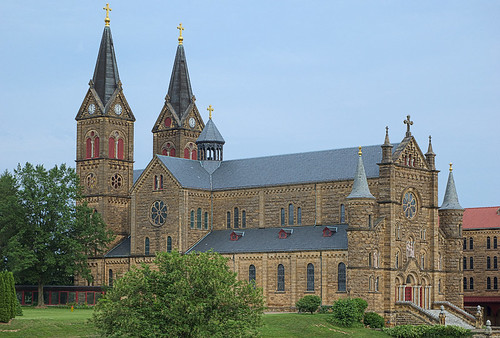
From the Abbey's website:
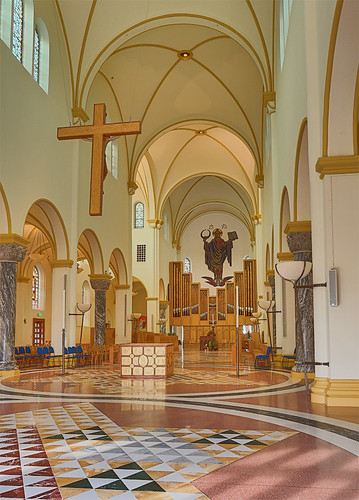
Nave of the church, looking to the west. Seating here is antiphonal; that is, the chairs and choir stalls face each other across the nave. According to the traditional form of prayer of the Divine Office, each side of the church alternately chants the verses of the Psalms and canticles. The monks chant mainly in English, based on Gregorian modes, along with some Latin: you can freely download or purchase their chant tones here, and view their musical catalog here.
According to the Visitor's Guide:

The new altar; here shown are scenes from the life, death, and resurrection of Christ, as well as symbols of the Evangelists.
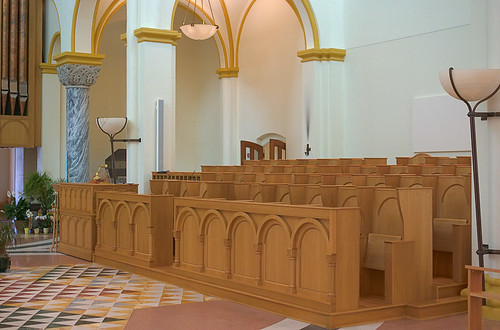
Monk's choir stalls; these face another set of stalls on the other side of the nave.
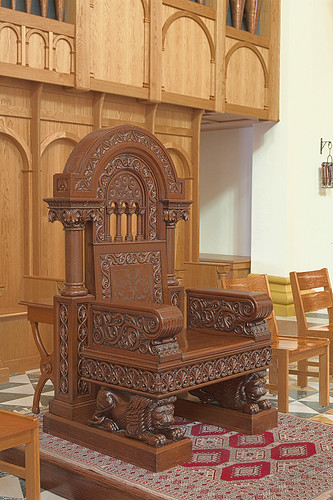
Archabbot's chair.
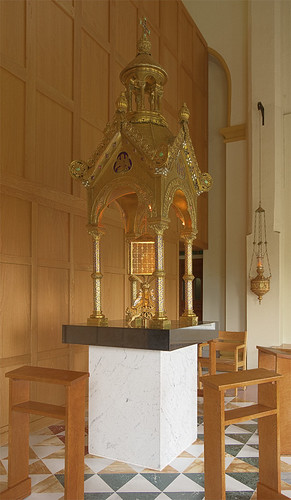
Tabernacle.

According to the Visitor's Guide:
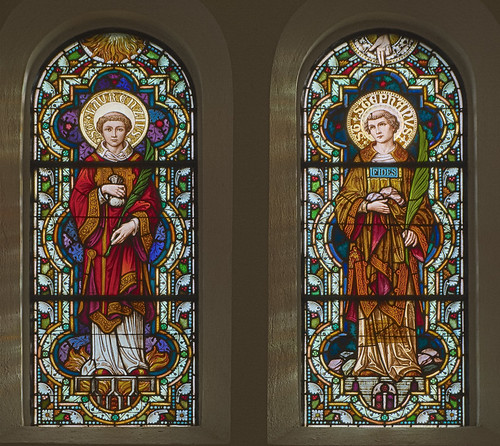
Windows showing the deacon-martyrs Saint Lawrence and Saint Stephen.
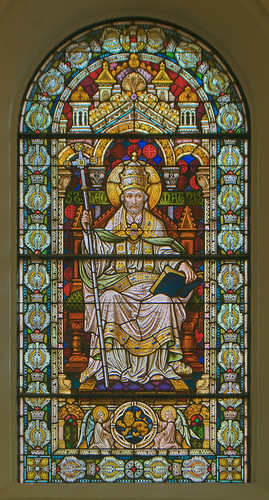
Saint Leo the Great
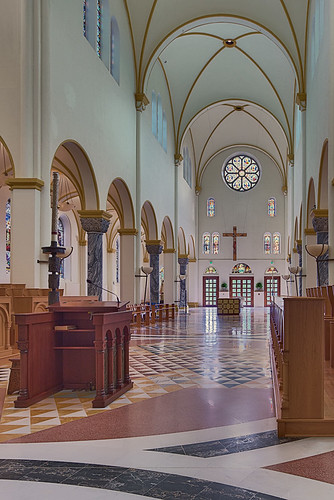
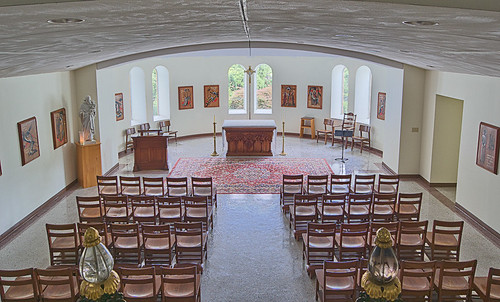
Under the church is Saint Joseph's Chapel.
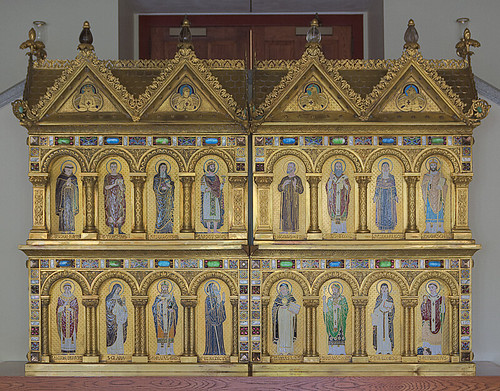
An ornate altarpiece in the chapel.
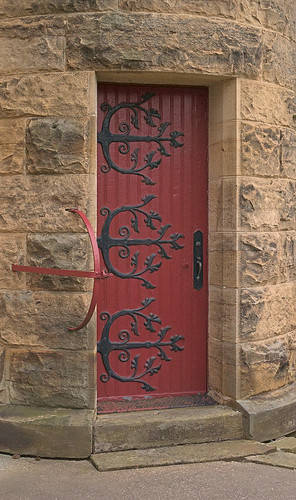
A side-door into the church
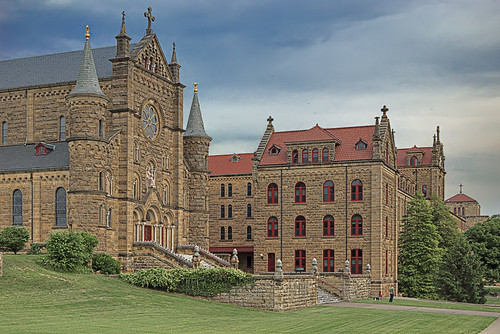
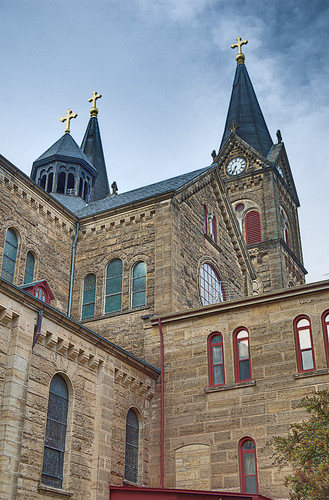
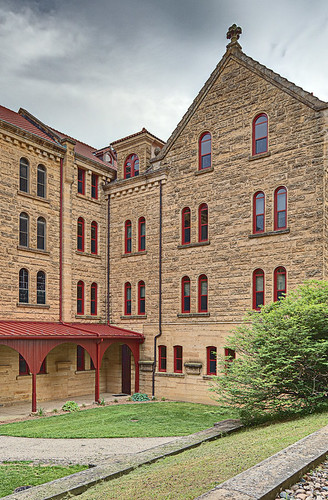
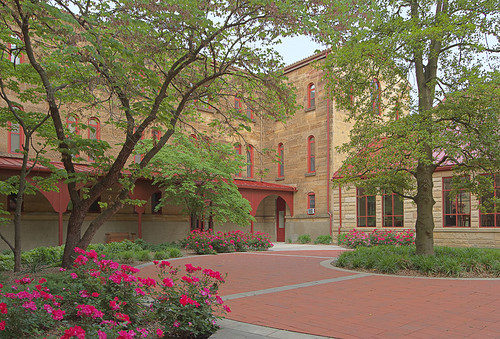
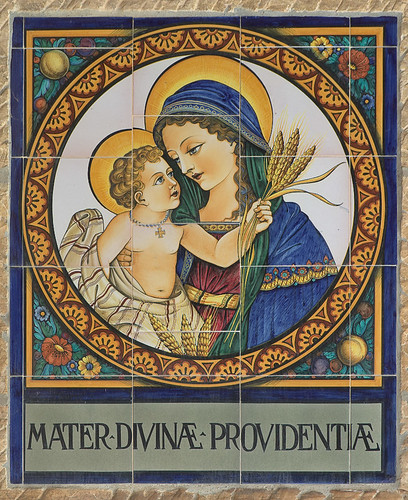
Virgin and Child in one of the courtyards.

Saint Bede Hall.
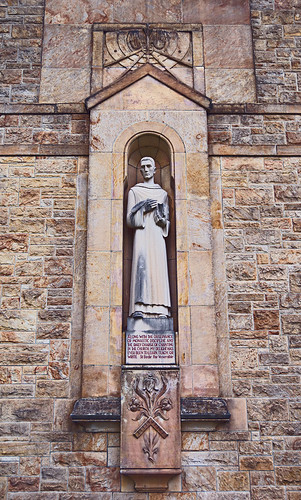
Statue of Saint Bede the Venerable (a.D. 673-735). He is know for writing the Ecclesiastical History of the English Nation, which includes early history of Britain.
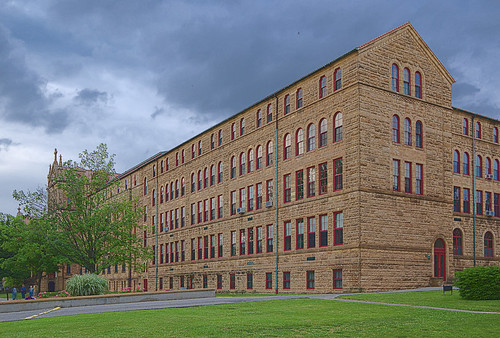
Newman Hall.
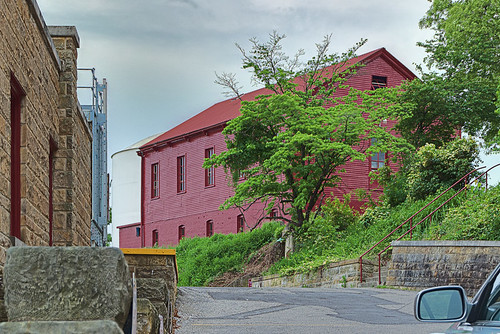
The auxiliary buildings here are often painted red.
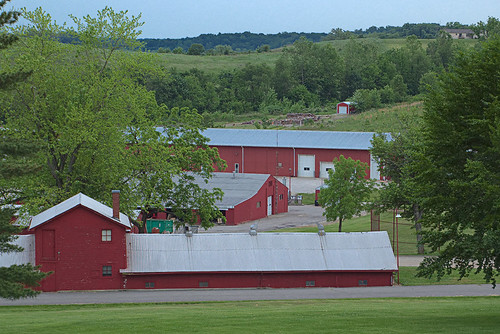
Besides the Graduate School, Saint Meinrad operates businesses, including Abbey Press and Abbey Caskets. According to the Benedictine tradition, monasteries are to be self-sufficeint; the monks live under the principle of ora et labora, or prayer and work.
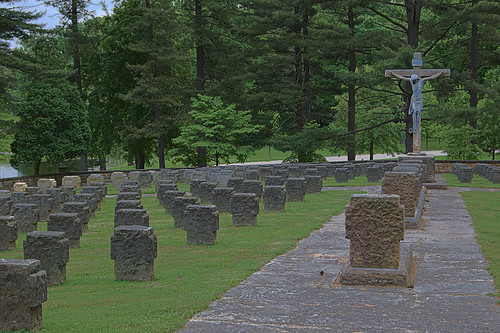
The monks' cemetery.
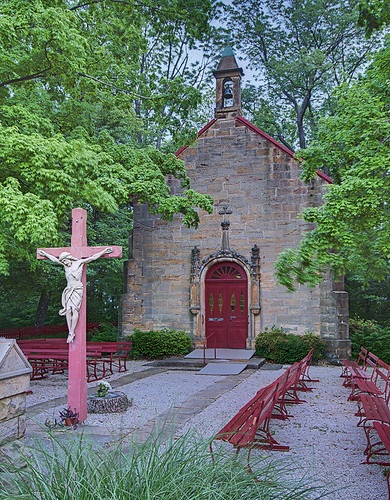
Two things I remember the most when visiting Saint Meinrad's: the monks chanting the Litany of Benedictine Saints and the Salve Regina, and the tiny Monte Cassino Shrine, located about a mile from the Abbey.
From the website:
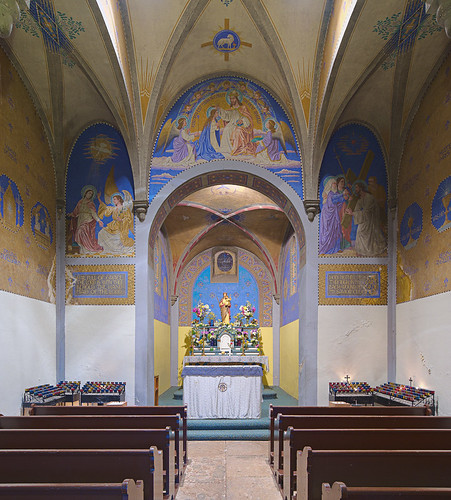
How can something be so small and so humble, yet be so rich?
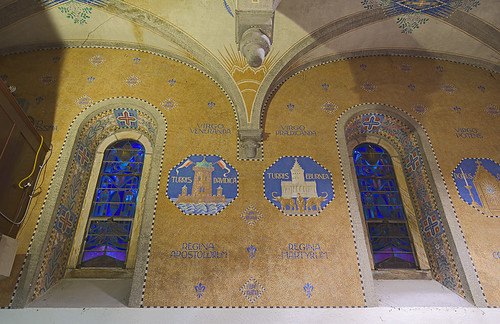
The chapel is decorated with Mary's many titles.
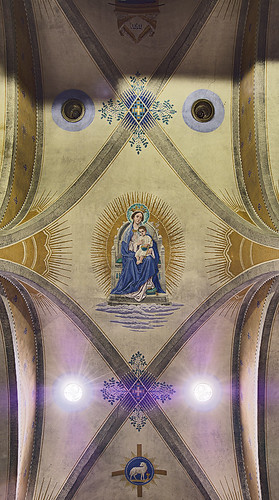
A view of the ceiling.
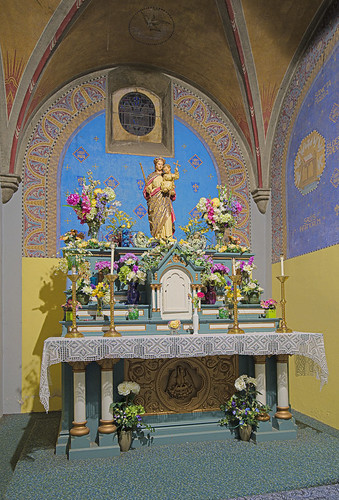

I was deeply touched by this shrine. If only I could linger longer, and not be distracted with the camera.

Jake, the famous Basset hound, eyes a package of Archabbey cookies.
Click here for a map of the area.
I took these photos over too brief of a time period, and my technique was sometimes sloppy. I hope to return here soon, so as to take more time, explore more places, and to participate in the monks' excellent liturgies. Many thanks to Cheryl, Tom, and Tina for making this trip possible.

From the Abbey's website:
Saint Meinrad Archabbey was founded in 1854 by monks from Einsiedeln Abbey in Switzerland. They came to southern Indiana at the request of a local priest for assistance in addressing the pastoral needs of the growing German-speaking Catholic population and to prepare local men to be priests.Saint Meinard was a Benedictine monk and holy hermit. He was killed by robbers in a.D. 861.
Both of these missions remain part of Saint Meinrad's ministry to the Roman Catholic Church, as Saint Meinrad operates a graduate school of theology and has more than a score of its monks in parish work, chaplaincies, and diocesan assignments.
The Benedictine community at Saint Meinrad consists of about 100 men who dedicate their lives to prayer and work. They gather in community five times a day-for morning prayer, noon prayer, evening prayer, compline and Mass-to pray for the Catholic Church and the world. Guests are welcome to join the monks in prayer in the Archabbey Church.
In addition, the monks spend private time reading spiritual and religious materials. They live by the wisdom and guidance of the Rule of St. Benedict, the sixth-century instructions for community living written by St. Benedict.
Shortly after arriving in Indiana, the Benedictines began offering high school courses to local youths. In 1861, the monks expanded their general courses to include undergraduate courses in philosophy and theology. Through these programs, the monks of Saint Meinrad began their mission, which continues today: preparing men for service in the Church as priests.

Nave of the church, looking to the west. Seating here is antiphonal; that is, the chairs and choir stalls face each other across the nave. According to the traditional form of prayer of the Divine Office, each side of the church alternately chants the verses of the Psalms and canticles. The monks chant mainly in English, based on Gregorian modes, along with some Latin: you can freely download or purchase their chant tones here, and view their musical catalog here.
According to the Visitor's Guide:
The Church was constructed during a seven-year period, ending in 1907. Monks and area townspeople built the Church, using sandstone quarried on the Archabbey's property at Monte Cassino and hauled in mule-drawn wagons. The blocks of stone, some three feet thick, were cut by hand.
The church was extensively redecorated in 1997.

The new altar; here shown are scenes from the life, death, and resurrection of Christ, as well as symbols of the Evangelists.

Monk's choir stalls; these face another set of stalls on the other side of the nave.

Archabbot's chair.

Tabernacle.

According to the Visitor's Guide:
Most of the Church's stained glass windows were made in Munich, Germany, and installed in 1908. The windows on the north and south walls depict the Beatitudes. The top section of each window represents an event from the life of a Benedictine saint that exemplifies the Beatitude. A corresponding scene from the Old Testament is depicted in the lower portion.The lower half of this windows shows the Old Testament Patriarch Joseph with Pharaoh.

Windows showing the deacon-martyrs Saint Lawrence and Saint Stephen.

Saint Leo the Great


Under the church is Saint Joseph's Chapel.

An ornate altarpiece in the chapel.

A side-door into the church





Virgin and Child in one of the courtyards.

Saint Bede Hall.

Statue of Saint Bede the Venerable (a.D. 673-735). He is know for writing the Ecclesiastical History of the English Nation, which includes early history of Britain.

Newman Hall.

The auxiliary buildings here are often painted red.

Besides the Graduate School, Saint Meinrad operates businesses, including Abbey Press and Abbey Caskets. According to the Benedictine tradition, monasteries are to be self-sufficeint; the monks live under the principle of ora et labora, or prayer and work.

The monks' cemetery.

Two things I remember the most when visiting Saint Meinrad's: the monks chanting the Litany of Benedictine Saints and the Salve Regina, and the tiny Monte Cassino Shrine, located about a mile from the Abbey.
From the website:
The small chapel of Monte Cassino is located on a hill near the Archabbey. Surrounded by trees and panoramic views of the Anderson Valley, the shrine dedicated to the Blessed Virgin Mary is a testament to the age-old tradition of seeking God.
The history of Monte Cassino Shrine tells how a novena to Our Lady of Monte Cassino is credited for saving the village of St. Meinrad from a smallpox epidemic in 1871. The faith that God's people placed in the intercession of Mary more than 130 years ago has not waned. Since the chapel's dedication in 1870, thousands of people have visited the sandstone chapel to offer their prayers and petitions.

How can something be so small and so humble, yet be so rich?

The chapel is decorated with Mary's many titles.

A view of the ceiling.


I was deeply touched by this shrine. If only I could linger longer, and not be distracted with the camera.

Jake, the famous Basset hound, eyes a package of Archabbey cookies.
Click here for a map of the area.
Monday, May 24, 2010
Saturday, May 22, 2010
Pentecost
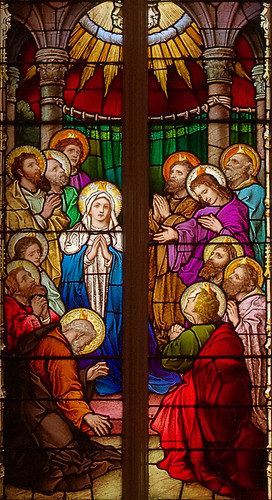
Stained glass window of the fire of the Holy Spirit descending on Mary and the Apostles on Pentecost. At Saint Alphonsus Liguori Church, in Saint Louis, Missouri.
From the Jewish Encyclopedia:
Pentecost: Name given by the Greek-speaking Jews to the festival which occurred fifty days... after the offering of the barley sheaf during the Passover feast... It is called, too, the "closing season of the Passover"...Pentecost marks the closing of the Paschal season. The descent of the Holy Spirit as tongues of fire led to the Apostles preaching in all tongues, to all nations. It marks the birthday of the Catholic — that is, universal — Church, which is made up of all nations and not just God's chosen nation of Israel. With the gifts of the Holy Spirit, we have the Law written on our hearts, and not just on tablets of stone.
The traditional festival of Pentecost as the birthday of the Torah (= "the time our Law was given"), when Israel became a constitutional body and "a distinguished people," remained the sole celebration after the Exile...
Thursday, May 20, 2010
Gothic Ornament at Washington University
WASHINGTON UNIVERSITY in Saint Louis is known for its fine architecture, particularly those buildings done in the Academic Gothic style. Here are some photographs of Gothic ornament, found while I made a brief visit to the school. This is hardly a thorough survey, and some of the pictures are a bit blurry.
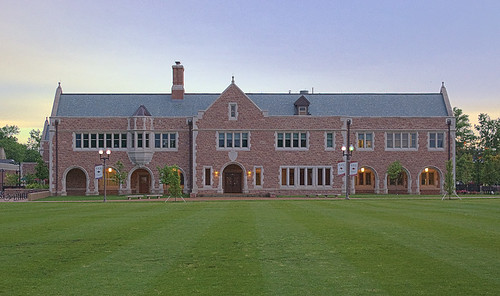
One of the newer buildings on campus, the Danforth University Center.
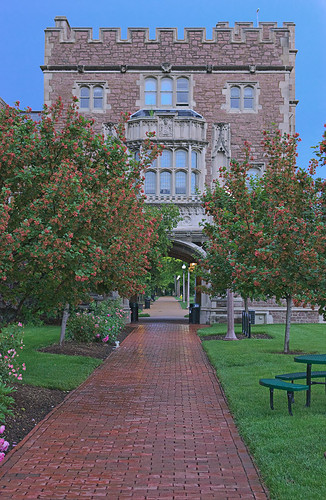
Here is McMillan Hall, where the following photos were taken.
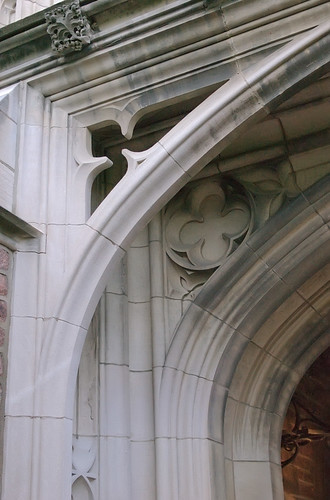
I imagine that hardly anyone today knows the principles of Gothic proportion; however, the elaborate designs were produced with simple rules and tools, which took into careful consideration the relative ratio in size between design elements.
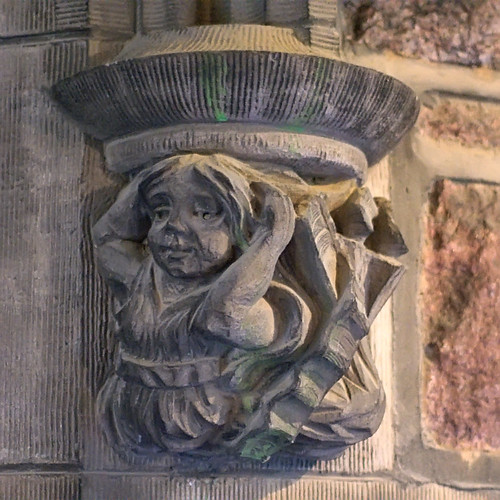
Often the meanings of various design elements are obscure; but these are undoubtably largely humorous. Even very fine Gothic churches will have some element of humor, especially in the more worldly and outer parts, far from the altar.
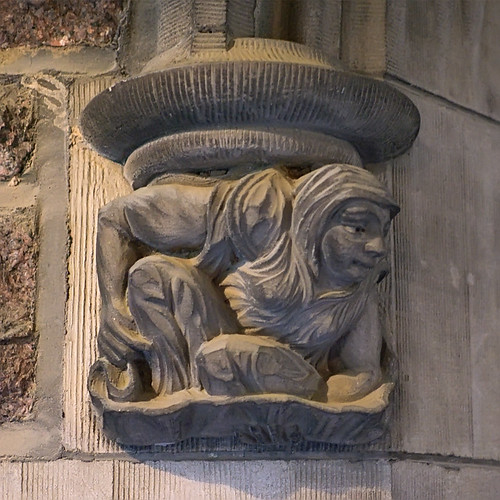
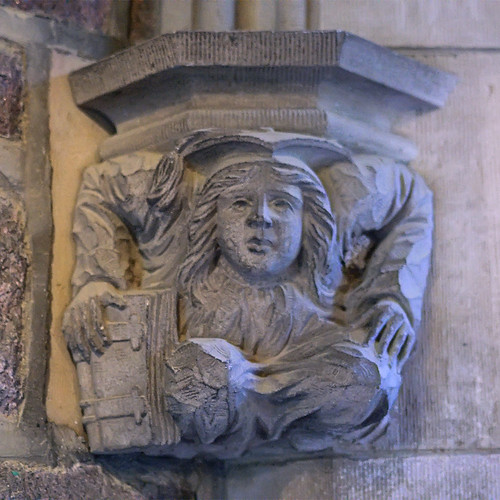
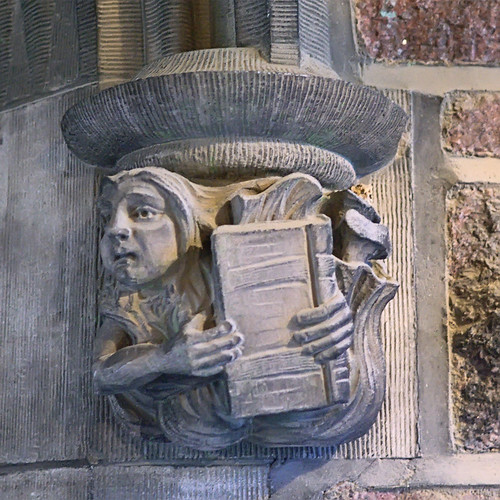
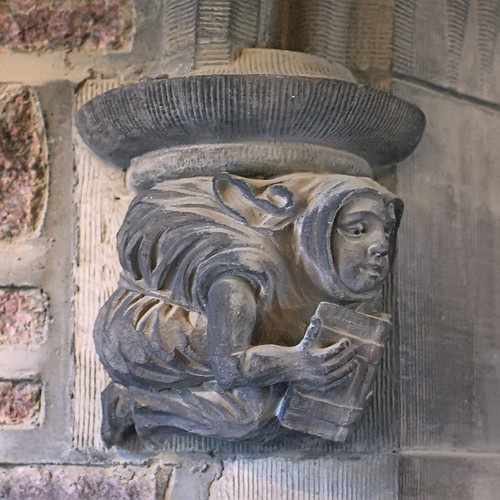
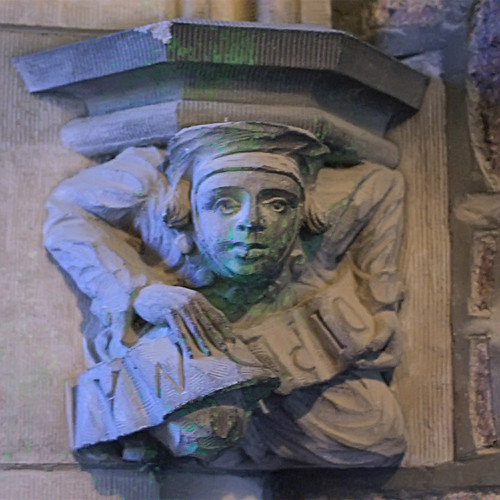
Diploma — the goal of most students!

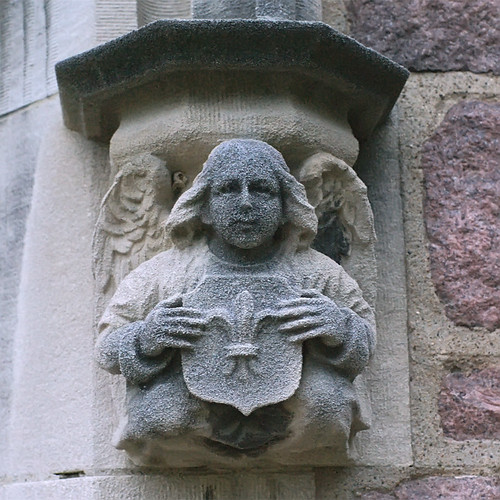
Fleur-de-lys.
The following were taken at the entrance to Graham Chapel, and in the authentic Gothic tradition, include natural scenes as well as fantastic beasts. Both McMillian Hall and Graham Chapel date from the early 20th century.
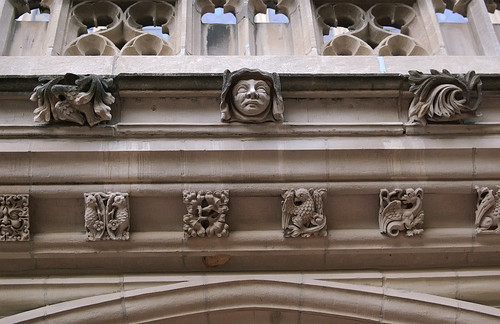
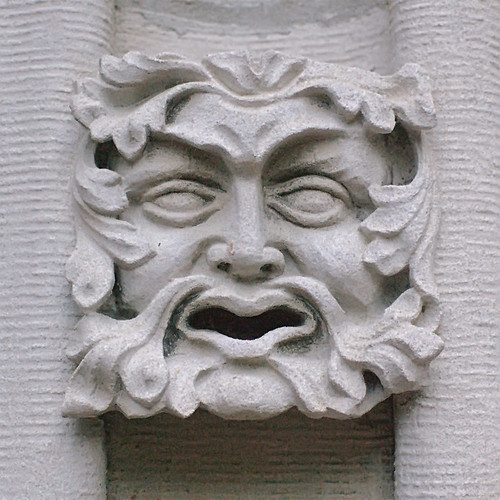
The Green Man.
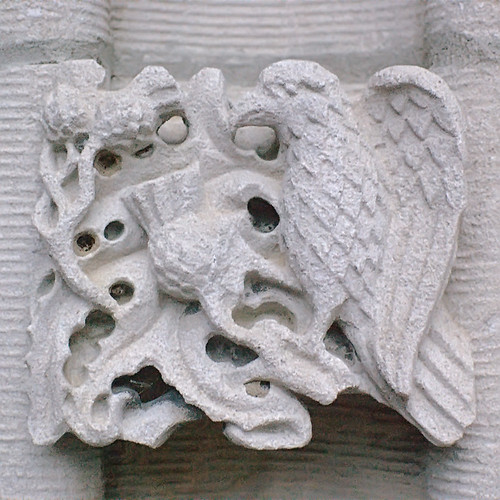
Eagle in thistle.

Both this figure and the following one are indeed sideways.
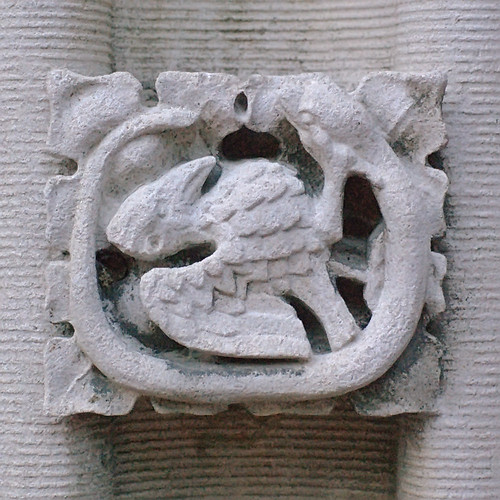
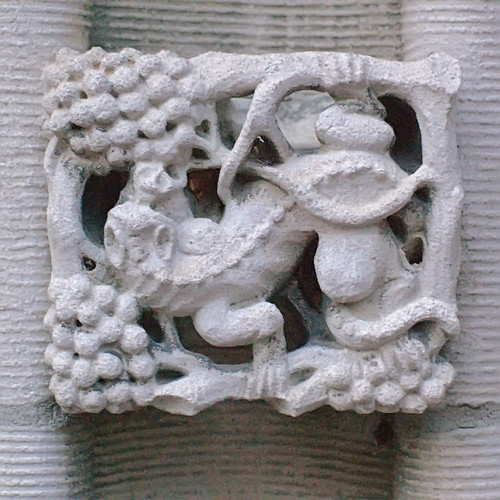
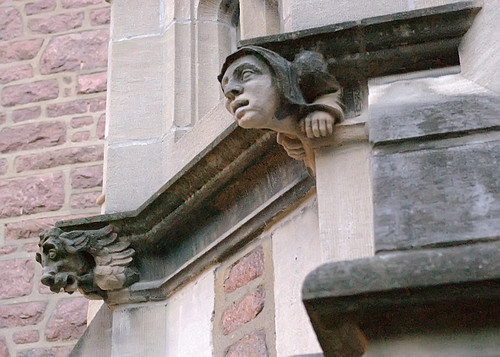
Beast and man as purely decorative gargoyles.
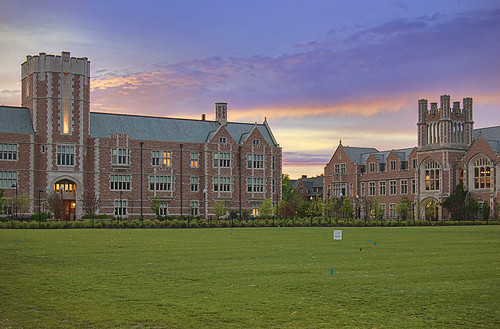
Some other newer buildings on campus.
http://www.wustl.edu

One of the newer buildings on campus, the Danforth University Center.

Here is McMillan Hall, where the following photos were taken.

I imagine that hardly anyone today knows the principles of Gothic proportion; however, the elaborate designs were produced with simple rules and tools, which took into careful consideration the relative ratio in size between design elements.

Often the meanings of various design elements are obscure; but these are undoubtably largely humorous. Even very fine Gothic churches will have some element of humor, especially in the more worldly and outer parts, far from the altar.





Diploma — the goal of most students!


Fleur-de-lys.
The following were taken at the entrance to Graham Chapel, and in the authentic Gothic tradition, include natural scenes as well as fantastic beasts. Both McMillian Hall and Graham Chapel date from the early 20th century.


The Green Man.

Eagle in thistle.

Both this figure and the following one are indeed sideways.



Beast and man as purely decorative gargoyles.

Some other newer buildings on campus.
http://www.wustl.edu

